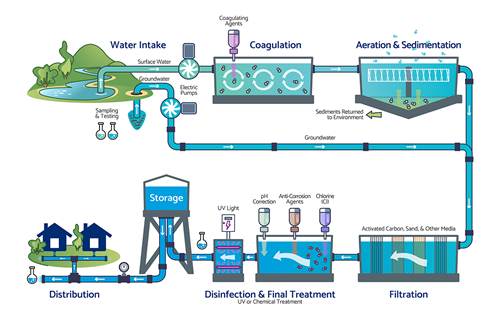How Utility Systems Work
Your water system is an exceptionally small part of our planet’s hydrologic (water) cycle. Yet collectively, our use and treatment of water has an enormous impact on our environment and wellbeing.
Water Utility Systems
The journey drinking, or potable, water takes to reach your tap can be a long one. In a regulated system such as yours, that involves considerable infrastructure, skilled operators, and numerous checks along the way to ensure it reaches your tap as clean, safe, reliable drinking water.
Drinking Water Treatment
Simplified Process

click to enlarge
Sources of Drinking Water
Your drinking water’s journey starts at one of two sources:
Groundwater
Pumped from aquifers (underground layers of porous rock) to the surface through wells. Groundwater was traditionally considered to be of higher purity than surface water, however; chemical contamination is an increasing concern across the US.
Surface Water
Pumped from freshwater lakes and rivers. Surface water is more susceptible to contamination, so usually requires more treatment.
You can learn where your drinking water comes from in your community’s Water Quality Reports.
It’s important to note all drinking water contains some naturally occurring elements that aren’t harmful to health, and some provide low levels of nutritional value and enhance its taste.
Treatment of Groundwater
Water is pumped from the well to the water treatment plant – sometimes a distance of several miles. Once it reaches the treatment plant, it’s passed through mechanical filters to remove particles, such as organic matter, silt, clay, iron, and manganese. If necessary, it’s passed through a chlorination or UV process to remove any bacteria, viruses, and protozoan parasites. Groundwater is regularly tested at source, and after it has passed through the treatment process.
Treatment of Surface Water
Surface water is more susceptible to contamination, so usually requires more complex treatment. Water is first pumped from reservoirs, lakes, or rivers; normally from depth where it is less disturbed. Once it reaches the water treatment plant, it passes through a sedimentation and aeration process. Aeration releases any volatile gases, and coagulating agents help filter out small particles in large settling tanks. It’s then sent through a series of long filtration tanks, which use gravel, sand, or activated carbon to further remove particles and pollutants. Finally, it passes through a chlorination and/or UV process to remove any remaining bacteria, viruses, and protozoan parasites. Surface water is regularly tested at source and throughout the treatment process.
Storage & Distribution
Once treated, drinking water is stored in large tanks and/or water towers. This ensures a reliable and constant supply for the community’s needs, including fire suppression (fire hydrants and reservoirs). The large volume of these tanks also increases the water’s pressure, reducing the need for additional pumps in the system.
From the storage tanks, an extensive network of watermains, made from iron or PVC, deliver clean pressurized water to homes and businesses. Watermain networks run under streets and sidewalks and can be many miles longer than street infrastructure. Customers connect, or “tap” into these public watermains through private service lines. Service lines often have a shut-off valve, or “curb stop”, and water meter installed before the line enters the building, though this can vary by jurisdiction and age of the installation. More information about service lines and meters can be found on the Water Meters & Leaks and Lead & Lead Service Lines pages.
Learn More
You can find articles on water on our News pages. And of course, we’re always happy to answer specific questions you may have about your services, our installations, and processes. Please contact Customer Service.
Online resources regarding water treatment technology, health and the environment, regulation, and public policy, are endless, but a good place to start is the U.S. Environmental Protection Agency’s (EPA) water resources pages, or your state government website.